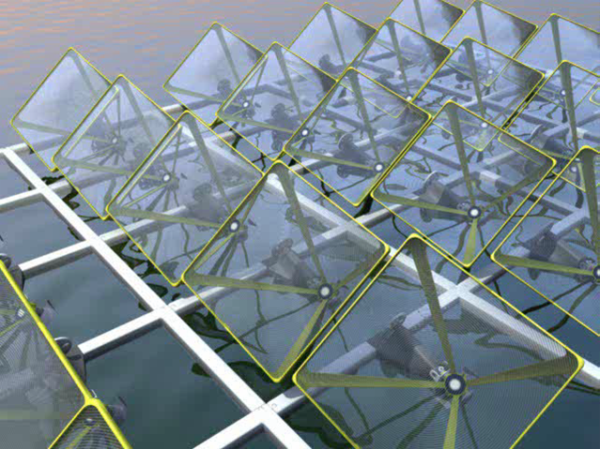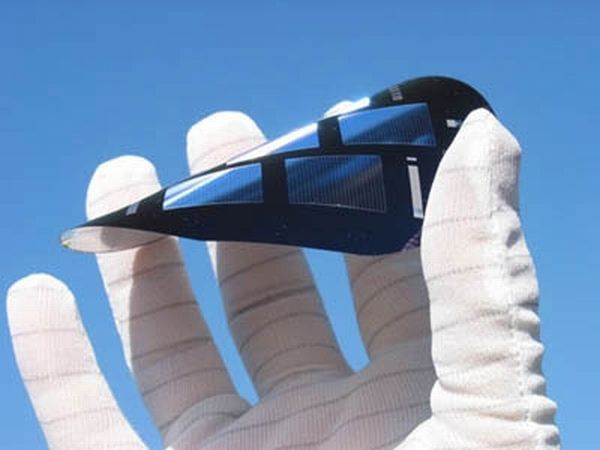For today’s world, which is thirsty for more amount of energy resources, the novel concept of floating solar plants can be a source of great joy and contentment. There will be many critics around there who feel that this is a far fetched idealism, impossible to be implemented. However, this is not a vague idea, that simply came to someone’s mind. Decades of experimentation has been done in this regard. It is a new approach in non conventional power generation, that not only culminates into economy of fuel, but even saves the acreage of land used to set up a functional solar farm. The proposed project aims at developing a solar farm on the surface of water. Considering the technological constraints at present, this will be developed in conjunction with hydroelectric power plants, to complement their efficiency.

Trends:
1. LSA: Floating solar panels for the ocean
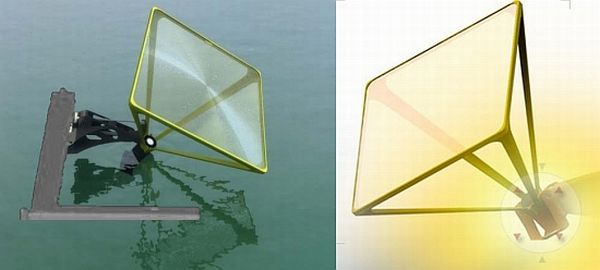
This project is named as Liquid Solar Array. The idea consists of placing a solar energy concentrator in the middle of ocean. The entire system is made of light weight plastic screen that functions like a lens. The concentrator focuses the incident radiation onto the photo diode placed at the such a point that, according to physics it will be at the fundamental focus.The entire system is so light that it floats on the surface of water due to floatation. During favorable weather condition, this concentrator converts all the incident radiation into emf. When the weather turns bad, it simply pops up and down on the surface of water like a buoy. Hence, it is a highly economical system which requires minimum technical maintenance. This system was developed by a company called Sunenergy of Australia. This project is being implemented all over the globe, even in India. The initial setup cost is considered to be about $1 million. They claim that their system can withstand all the harsh manifestations of nature.
The success of the first prototype inspired many other countries to develop a floating solar plant. Prominent among them are India, France, Israel and USA. The research is being done in India by Tata powers, in collaboration with Sunenergy. Many tests are being carried out at sophisticated research centers around the globe to test the capability and efficiency of this system.
EDF Group of France and Solaris Synergy of Israel entered into a joint venture to test this floating solar plant at Cadarache in SE France. The engineers are even verifying the environmental impact of this project, like whether the presence of LSA will affect the penetration of oxygen into the aquatic ecosystem.
2. Seoul’s floating island
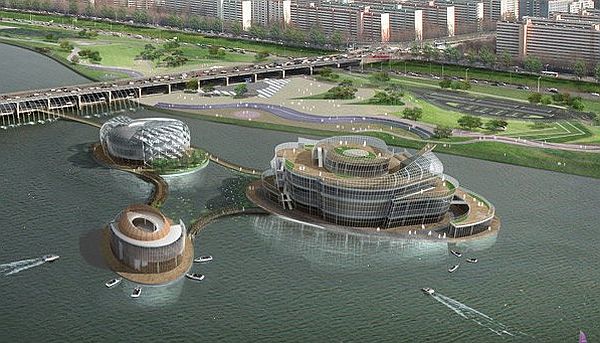
Another remarkable masterpiece was developed at Seoul, in South Korea. They developed a floating island that was launched in September 2011. The entire construction has been carried out using privately owned funds. It is already revealed that this is not exactly a floating solar power plant.
This remarkable architecture consists of three islands floating leisurely in the middle of the river Han.The three islands are chained to each other by water proof chains and the complete island is secured by means of a buoy. The three islands were designed to perform three distinct activities.
As it can be seen from the picture, the largest of the three islands is situated near the waterfall of Banpo Bridge at the Banpo Hangang Park. It is three storied and houses a convention center, capable of seating 700 people. On the rooftop is the business center.
Now a doubt may arise, as to what exactly is so unique in this project?
The main defining feature is that the roof of this island is covered with solar panels, thus powering the entire island. The solar panels has been set over an area of 54 meter square and is capable of supplying every room with 6 kilowatts every day.
The second island was developed to be a center of cultural activity. It is aimed at promoting art and other cultural activities that form a part of the heritage of South Korea.
The third and the last island is for public entertainment, where the public can participate in various water sports, like yachting, etc.
It will be again highlighted that the entire island is powered from solar panels installed on each island, without deriving even a watt of power from the power grid. Thus, it is a self sufficient island satisfying all its needs in a sustainable manner.
3. Floating solar lily pads
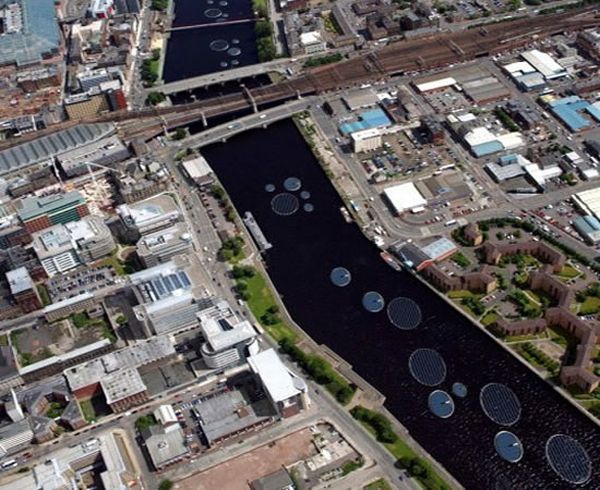
The third specimen of the floating type of solar power plants was seen at Glasgow. ZM Architecture of Glasgow developed a floating type of solar power plant designed in the form of water lilies. These Solar Lily Pads were installed at Clyde river. These lily pads are essentially photovoltaic cells, efficient enough to convert the incident solar radiation into electric power. Additional feature of this pad is that the pads governed by electric motors that rotates the pad with the variation of intensity of solar radiation, so that the system woks with optimum efficiency. The architects integrated the system with the electric grid to optimize its performance and energy transmitting capacity.
The concept:
The main feature to be seen with all the systems discussed so far is that all of them were installed on the surface of water, with land use only for anchoring.
a. In case of LSA, the photovoltaic cells were surrounded by plastic lens, that focuses all the incident radiation on to the cell. This extracts maximum power from the sun.The entire system has been designed to withstand cyclone, tides, etc. so that it can perform the task optimally. That is why it has been designed like a raft so that it remains afloat.
b. The Seoul’s Floating Island was aimed at inspiring the world that a self sufficient building can be built. It was mainly constructed as an island only to derive maximum efficiency from the sun and to economize the land that would have required for a similar construction within the city.
c. The Floating Solar Lily pads displayed that if the solar panels are exposed to maximum solar radiations, then maximum power can be extracted. Also, the motors underneath the pads tilt the pads with variation in solar intensity, either due to rotation or cloud cover.
The advantages:
a. A lot of land could be saved by the development of projects like these.
b. It is very economical as the initial set up cost is less than that of any other power plants and even ordinary solar farms.
c. There is no need of technical maintenance. So the maintenance cost can be saved.
d. Very less amount of materials are required in its fabrication. Hence, material can also be saved.
e. As it is proposed to develop this project to complement the hydro electric power plants.This will rise the overall efficiency of hydro electric power plants.
f. The additional power produced can be used to meet the rising demand for power.
g. There is no use of fossil fuel in the energy production. So it is environment friendly and does not contribute to Global Warming.
The impact:
With technologies like these power can be provided to developing countries like India, where 70% of the population still lives in darkness. As it was mentioned, the implementation of this technology does not require much land. So, for a country like India, Africa, etc. where huge population thrives, this technology can be a boon. Since it is proposed to install this system in conjunction with hydroelectric power plants for the initial stage, the efficiency of the hydroelectric plant increases. Since, there is no use of conventional energy resources, mining of the land to extract coal will be reduced. This reduces the environmental impact of mining like landslides, drought,etc.
In a nutshell, the implementation of this technology helps the nation to produce cheap power.


